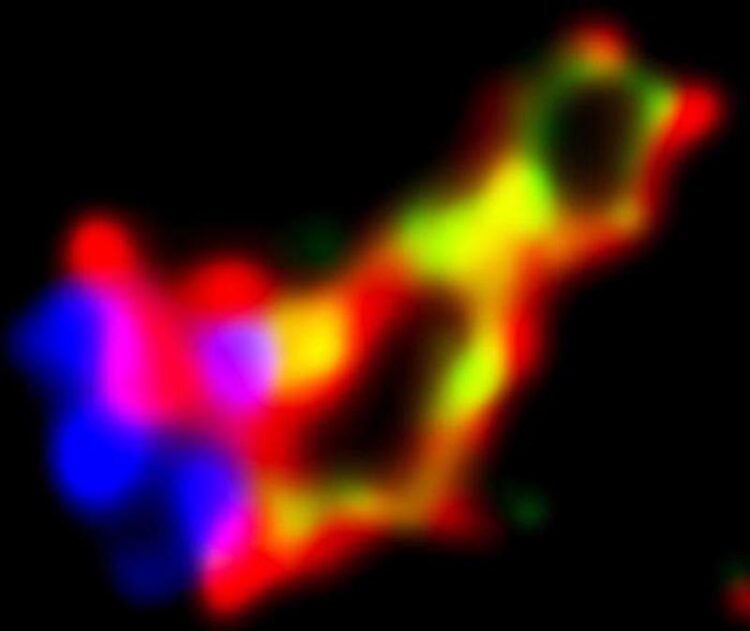New genetic analysis tool tracks risks tied to CRISPR edits

UC San Diego researchers have created a new system that reveals specific categories of potentially risky mutations resulting from CRISPR edits. This high magnification image reveals CRISPR-based DNA transcription of the homothorax gene in a fruit fly embryo.
Credit: Bier Lab, UC San Diego
Classification system uses genetic fingerprints to identify unintentional ‘bystander’ edits linked with new disease therapies.
Since its breakthrough development more than a decade ago, CRISPR has revolutionized DNA editing across a broad range of fields. Now scientists are applying the technology’s immense potential to human health and disease, targeting new therapies for an array of disorders spanning cancers, blood conditions and diabetes.
In some designed treatments, patients are injected with CRISPR-treated cells or with packaged CRISPR components with a goal of repairing diseased cells with precision gene edits. Yet, while CRISPR has shown immense promise as a next-generation therapeutic tool, the technology’s edits are still imperfect. CRISPR-based gene therapies can cause unintended but harmful “bystander” edits to parts of the genome, at times leading to new cancers or other diseases.
Next-generation solutions are needed to help scientists unravel the complex biological dynamics behind both on- and off-target CRISPR edits. But the landscape for such novel tools is daunting, since intricate bodily tissues feature thousands of different cell types and CRISPR edits can depend on many different biological pathways.
University of California San Diego researchers have developed a new genetic system to test and analyze the underlying mechanisms of CRISPR-based DNA repair outcomes. As described in Nature Communications, Postdoctoral Scholar Zhiqian Li, Professor Ethan Bier and their colleagues developed a sequence analyzer to help track on- and off-target mutational edits and the ways they are inherited from one generation to the next. Based on a concept proposed by former UC San Diego researcher David Kosman, the Integrated Classifier Pipeline (ICP) tool can reveal specific categories of mutations resulting from CRISPR editing.
Developed in flies and mosquitoes, the ICP provides a “fingerprint” of how genetic material is being inherited, which allows scientists to follow the source of mutational edits and related risks emerging from potentially problematic edits.
“The ICP system can cleanly establish whether a given individual insect has inherited specific genetic components of the CRISPR machinery from either their mothers or fathers since maternal versus paternal transmission result in totally different fingerprints,” said Bier, a professor in the UC San Diego School of Biological Sciences.
The ICP can help untangle complex biological issues that arise in determining the mechanisms behind CRISPR. While developed in insects, ICP carries vast potential for human applications.
“There are many parallel applications of ICP for analyzing and following CRISPR editing outcomes in humans following gene therapy or during tumor progression,” said study first author Li. “This transformative flexible analysis platform has many possible impactful uses to ensure safe application of cutting-edge next-generation health technologies.”
ICP also offers help in tracking inheritance across generations in gene drive systems, which are new technologies designed to spread CRISPR edits in applications such as stopping the transmission of malaria and protecting agricultural crops against pest destruction. For example, researchers could select a single mosquito from the field where a gene-drive test is being conducted and use ICP analysis to determine whether that individual had inherited the genetic construct from its mother or its father, and whether it had inherited a defective element lacking the defining visible markers of that genetic element.
“The CRISPR editing system can be more than 90 percent accurate,” said Bier, “but since it edits over and over again it will eventually make a mistake. The bottom line is that the ICP system can give you a very high-resolution picture of what can go wrong.”
In addition to Li and Bier, coauthors included Lang You and Anita Hermann. Prior Bier lab member Kosman also made important intellectual contributions to this project.
Journal: Nature Communications
DOI: 10.1038/s41467-024-46479-2
Method of Research: Experimental study
Subject of Research: Animals
Article Title: Developmental progression of DNA double-strand break repair deciphered by a single-allele resolution mutation classifier
Article Publication Date: 23-Mar-2024
COI Statement: Professor Ethan Bier has equity interest in two companies he co-founded: Agragene Inc. and Synbal Inc., which may potentially benefit from the research results. He also serves on Synbal’s board of directors and the scientific advisory boards for both companies.
Media Contact
Mario Aguilera
University of California – San Diego
maguilera@ucsd.edu
Office: 858-822-5148
All latest news from the category: Life Sciences and Chemistry
Articles and reports from the Life Sciences and chemistry area deal with applied and basic research into modern biology, chemistry and human medicine.
Valuable information can be found on a range of life sciences fields including bacteriology, biochemistry, bionics, bioinformatics, biophysics, biotechnology, genetics, geobotany, human biology, marine biology, microbiology, molecular biology, cellular biology, zoology, bioinorganic chemistry, microchemistry and environmental chemistry.
Newest articles

NASA: Mystery of life’s handedness deepens
The mystery of why life uses molecules with specific orientations has deepened with a NASA-funded discovery that RNA — a key molecule thought to have potentially held the instructions for…

What are the effects of historic lithium mining on water quality?
Study reveals low levels of common contaminants but high levels of other elements in waters associated with an abandoned lithium mine. Lithium ore and mining waste from a historic lithium…

Quantum-inspired design boosts efficiency of heat-to-electricity conversion
Rice engineers take unconventional route to improving thermophotovoltaic systems. Researchers at Rice University have found a new way to improve a key element of thermophotovoltaic (TPV) systems, which convert heat…



